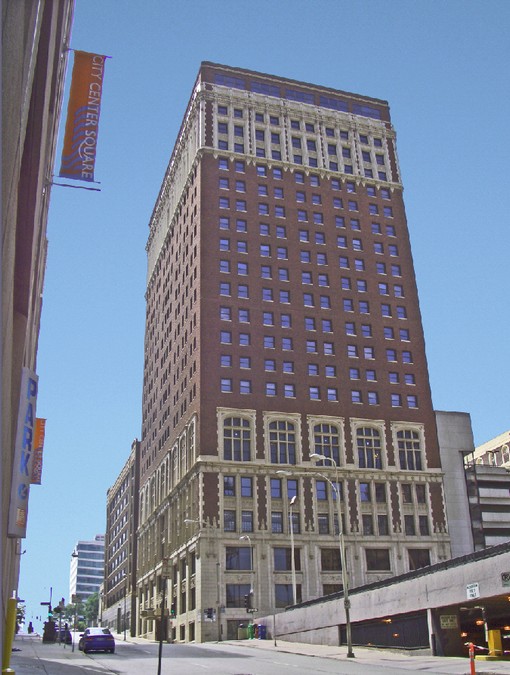Mark Twain Tower (Continental Hotel)
Introduction
Text-to-speech Audio
Constructed in 1923, Kansas City'shistoric Mark Twain Tower which was also known as the Continental Hotel connects several aspects of history from the rise of athletic clubs to the effects of the Great Depression and urban history. The building was home to the Kansas City Athletic Club which formed during the 1880s as the club moved into the building in the 1920s. The Continental Hotel took over the historic skyscraper in the 1930s and maintained ownership until the 1970s, although the Athletic Club continued to occupy several floors. The Playboy Franchise also operated a Playboy Club within the hotel during the 1960s. Similar to many other buildings in the downtown area, the structure now operates as an apartment complex.
Images
2008 photo of Mark Twain Tower (Continental Hotel) in Kansas City

Backstory and Context
Text-to-speech Audio
The twenty-three-story Mark Twain Tower opened in 1923 as the Kansas City Athletic Club, consisting of a ballroom, gymnasium, swimming pool, squash and racquetball courts, and other fitness uses. Arthur E. Stillwell founded the club in 1887, then a bicycling club known as the Fairmount Cycling Club, in Fairmount Park (Kansas City); the club formation represented the early stages of the "bike boom" that materialized by the late nineteenth century. But, Americans enjoyed more than just bikes by the 1890s. The focus on health and the creation of athletic clubs grew increasingly popular as the turn of the twentieth century approached; the club changed to the Kansas City Athletic Club in 1893.
By the early twentieth century, the Kansas City Athletic Club gained fame for its Amateur Athletic Union teams. Beginning in the early 1900s, the club's amateur basketball team, the Blue Diamonds, became a nationally known powerhouse, including winning the "national championship" at the 1904 World's Fair in St. Louis. Even in the 1920s, they competed in the same brackets as universities and clubs and reached six national championship games, winning twice.
Despite the club's success in producing championship-caliber basketball teams, the Kansas City Athletic Club could not raise enough funds to purchase a new clubhouse. They first approached The Kansas City Club in 1917 with a proposal to merge the two clubs, but the Kansas City Club, one of many social clubs that developed in American cities during the Gilded Age and catered to social and business elites, rejected their offer. Instead, the Athletic Club purchased the unfinished, now-historic twenty-two-story building in 1923; construction had begun in 1917, but delays kept it from being completed. The club hired architects to finish the structure, which included plans to build a two-story ballroom, gymnasium, a near Olympic-sized swimming pool, athletic courts, and general fitness rooms.
The Great Depression took its toll on the Athletic Club, forcing the organization to sell the building to the Continental Hotel, although the club maintained a presence on several floors. The Continental Hotel opened in 1938 and remained in operation for more than thirty years. One of its most notable comprised the Playboy Club, which opened in 1964, in the hotel's top-floor ballroom. The gentlemen's club featured a full-service restaurant, a banquet room and two show rooms where both local and nationally-known entertainers performed. But, the club's main feature involved the "bunnies," women dressed in tight, revealing clothing (and bunny ears) serving drinks to men, all part of Hue Hefner's image for Playmates and Playboy bunnies. The club and hotel ceased operations during the 1970s.
In 1982, the building converted into an office building after extensive renovations, and its name changed to the Mark Twain Tower. Nevertheless, the building's original owners, the Kansas City Athletic Club, retained the rights to occupy the top six floors. By the late 2010s, with occupancy less than twenty percent, a group purchased the building and proposed to transform the historic downtown building into an apartment building; the group spent $60 million on the building to preserve its historical value while also changing its function.
Sources
"America at Leisure." Library of Congress. loc.gov. Accessed September 10, 2021. https://www.loc.gov/collections/america-at-work-and-leisure-1894-to-1915/articles-and-essays/america-at-leisure/.
Bradley, Donald. "Kansas City Club's history is up for bid, piece by piece." The Kansas City Star (Kansas City), August 21, 2015. https://amp.kansascity.com/article31769244.html.
Collison, Kevin. "Mark Twain Tower, Major Preservation Project, Opens to Residents in August." CityScene KC. cityscenekc.com. June 22, 2022. https://cityscenekc.com/mark-twain-tower-big-preservation-project-opens-to-residents-in-august/.
--- --- ---. "One of Downtown's Last Big, Empty Historic Buildings Slated for Apartments." CityScene KC. cityscenekc.com. November 29, 2018. https://cityscenekc.com/one-of-downtowns-last-big-empty-historic-buildings-slated-for-apartments/.
Ferruzza, Charles. "Before the Playboy Club was a TV series, it was a Kansas City hot spot." The Pitch. thepitchkc.com. September 26, 2011. https://www.thepitchkc.com/before-the-playboy-club-was-a-tv-series-it-was-a-kansas-city-hot-spot/.
Friss, Evan. The Cycling City: Bicycles and Urban America in the 1890s. Chicago: University of Chicago Press, 2015.
Handy, Bruce. "A Bunny Thing Happened: An Oral History of the Playboy Clubs." Vanity Fair. vanityfair.com. April 22, 2011. The article first appeared in the Vanity Fair print book, May 2011 issue. https://www.vanityfair.com/news/2011/05/playboy-clubs-201105.
Kirkman, Paul. "Kansas City's First World Championship Team" in Forgotten Tales of Kansas City, p. 89. Charleston, SC: Arcadia Publishing Incorporated, 2012.
Roberts, Rob. "$50M effort will transform historic building into The Continental apartments." Kansas City Business Journal. bizjournals.com. December 15, 2016. https://www.bizjournals.com/kansascity/news/2016/12/15/mark-twain-tower-conversion-continental-apartments.html.
Woods, David. "Butler heads back to K.C., site of two of its greatest hoop victories." IndyStar. November 24, 2019. https://www.indystar.com/story/sports/college/butler/2019/11/24/butler-basketball-heads-kansas-city-site-2-its-greatest-wins/4284135002/.
By User:Charvex - Self-photographed, Public Domain, https://commons.wikimedia.org/w/index.php?curid=4411248
